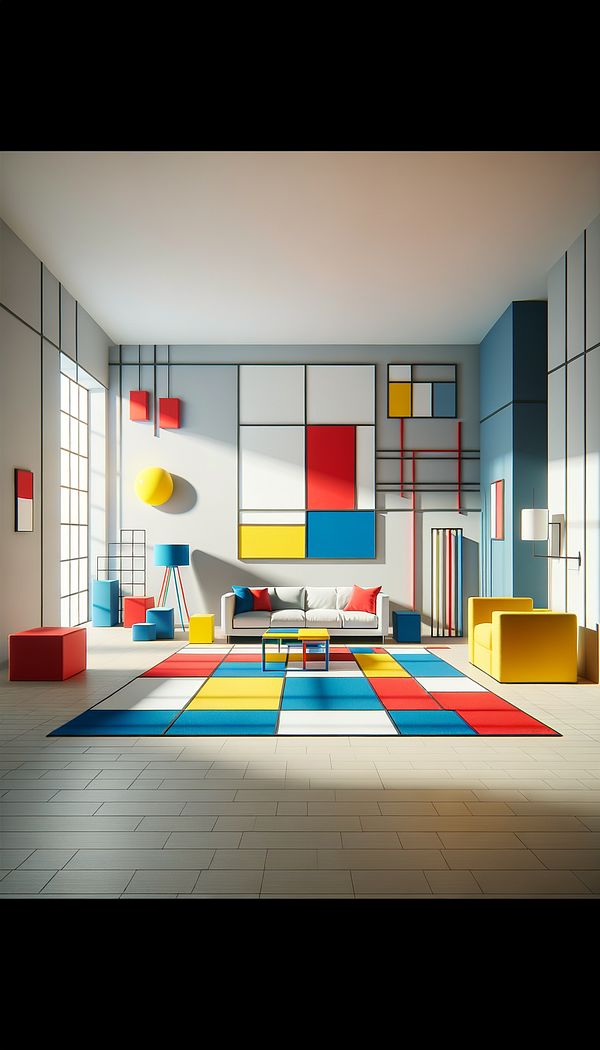What is De Stijl?
De Stijl is an art movement that emphasizes abstraction and simplification.
Description
De Stijl, Dutch for "The Style," also known as Neoplasticism, is a movement that originated in the early 20th century and embraces an abstract, minimalist aesthetic. Founded in 1917 by Piet Mondrian and Theo van Doesburg, De Stijl advocates for the reduction of form and color to its most basic elements. It is characterized by the use of straight lines, right angles, primary colors (red, blue, and yellow), along with black, white, and gray. The movement sought to express a new utopian ideal of spiritual harmony and order through this simplification and abstraction.
In the context of interior design, De Stijl has significantly influenced various elements, including the layout, furniture, and decorative elements of a space. Its influence encourages a harmonious and clutter-free space that uses geometric forms and primary colors to create a dynamic but balanced aesthetic. This style goes beyond mere decoration; it embodies a philosophy of unity and simplicity, advocating for spaces that aren't just visually appealing but also serve as a reflection of universal values.
The principles of De Stijl can be applied not just in painting and architecture, but across a range of design fields, including graphic design, furniture, and interior design. The movement has left a lasting legacy in modern design, continuing to inspire designers and architects who value minimalism, coherence, and the expressive power of primary colors and simple forms.
Usage
An example of De Stijl in interior design is the Rietveld Schröder House in Utrecht, Netherlands, designed by Gerrit Rietveld. The house features elements typical of De Stijl, such as a flexible, open-plan layout, the use of primary colors and non-colors, and furniture designed with simple geometric shapes. Furthermore, contemporary interior designers often incorporate De Stijl's principles by using modular furniture and bold, primary-colored accents to create spaces that feel both modern and timeless.
FAQs
-
Who are the key figures in the De Stijl movement?
The key figures in the De Stijl movement include its co-founders, painter Piet Mondrian and architect Theo van Doesburg. Gerrit Rietveld, a furniture designer and architect, also played a significant role in the movement.
-
How does De Stijl differ from other art movements?
De Stijl is distinct for its emphasis on abstraction, simplification to basic elements, and the use of primary colors and non-colors, setting it apart from other movements that might prioritize naturalistic representations or a broader color palette.
-
Can De Stijl principles be applied in contemporary design?
Yes, De Stijl principles, such as minimalism, the use of primary colors, and the emphasis on functional and geometrical forms, are often incorporated in contemporary design, influencing everything from interior design to graphic design.
Practical Application
Incorporating De Stijl principles into your interior design can involve adopting a minimalist layout, using furniture with simple lines and shapes, and strategically implementing primary colors alongside black, white, and gray. Consider the balance and flow of space, aiming for a clean, open feel that allows each element to exist in harmony with the others.
-
Design Styles478 articles
-
Furniture Types599 articles
-
Decorative Techniques322 articles
-
Historical Periods & Movements150 articles
-
Color & Patterns154 articles
-
WebbingWebbing is a strong, flexible strip of fabric used in furniture construction.
-
French RegenceFrench Regence is a decorative style of interior design developed in France between 1715 and 1723.
-
Kitchen CartA kitchen cart is a mobile workstation and storage unit designed for use in the kitchen.
-
MoiréMoiré is a unique visual phenomenon produced by the superimposition of two or more sets of fine patterns or grids.
-
Drum DyeingDrum dyeing is a leather coloring process where hides are tumbled in a rotating drum with dye solutions.
